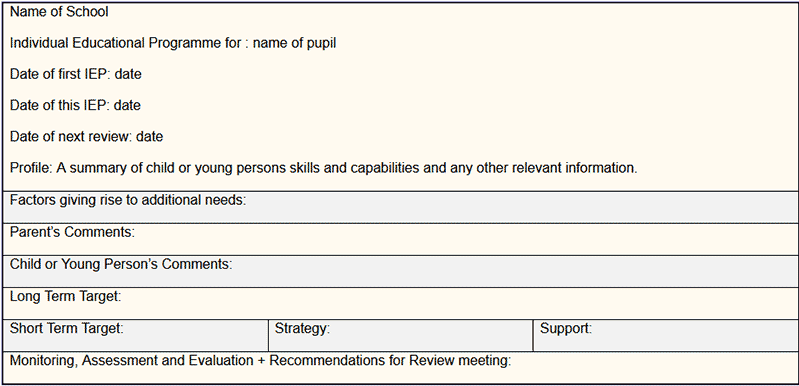Individualised Educational Programmes
Where children or young people require more detailed planning in one or more areas than can be catered for through the process of personal learning planning and generic programmes of support, or where substantial adaptation to the curriculum, the approach to learning and teaching or the deployment of resources is being considered, an Individualised Educational Programme (IEP) may be appropriate.
An IEP is a written plan outlining the steps to be taken to enable a child or young person with additional support needs to achieve specified targets. It provides the planning framework which underpins the teaching, learning and support processes by which a child’s additional support needs can be addressed within an educational context. The nature and scale of IEPs will vary with the needs of the individual. Some IEPs will be short while others will be more extensive documents.
An IEP should be a functional document and the format may need to be individualised to suit the needs of the child or young person and/or the nature of the adaptation being considered. However it should normally include details about the nature of the child or young person’s additional support needs, the ways in which these are to be met, the learning outcomes in the relevant area or areas to be achieved both long and short term targets and the additional support being provided. The class or subject teacher has overall responsibility for the implementation of targets within an IEP. Where targets are to be implemented in a range of settings, for example, across a number of secondary school departments, the establishment of a key, co-ordinating role is essential.
An IEP should be developed collaboratively by parents or carers and the school, and by the child or young person if they have the capacity to participate.
It should also be remembered that a child or young person might require an IEP in one school or class, because individual differentiation is required, but not require an IEP in a school or class where many other pupils also have similar needs.
Whatever the context an IEP should always be:
- A dynamic response to individual needs.
- Rooted within the planning for all the children in the group or class.
- A programme which provides opportunities for a balanced range of experiences.
- Inclusive in context.
- Positive in tone.
An IEP is not:
- A separate programme of disjointed targets.
- Undertaken by the pupil in isolation.
- Negative in tone, concentrating on the child’s weaknesses.
The process of developing the IEP is not just about writing a document. It offers opportunities:
- To help school staff, other professionals and parents or carers to develop increased knowledge and understanding of the pupil by learning about how the pupil is in other contexts.
- For parents or carers and professionals to develop joint commitments to working to achieve shared and agreed aims and targets on behalf of the pupil.
- For parents or carers to develop their understanding of how the school is working with their child and in collaboration with other professionals to meet their child’s needs.
- For the members of the school team and wider support network to identify and own their responsibilities to the pupil.
The following generic template is offered.






